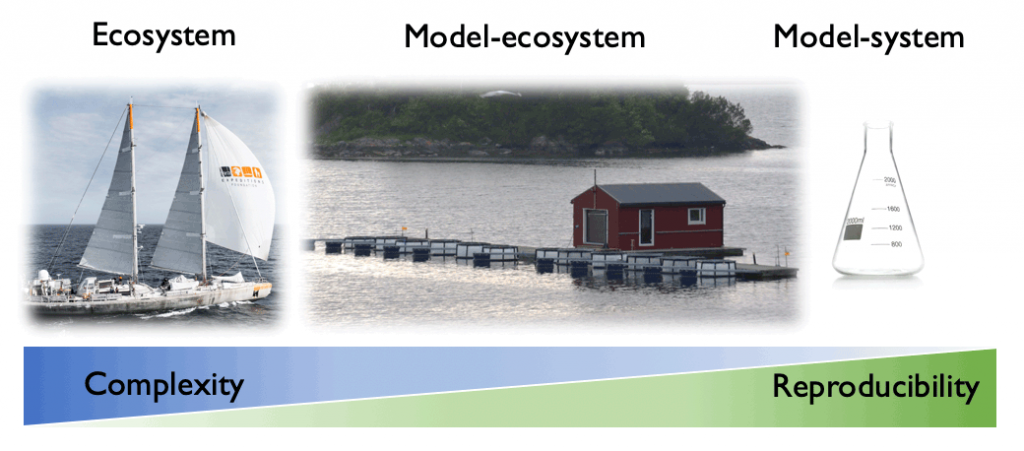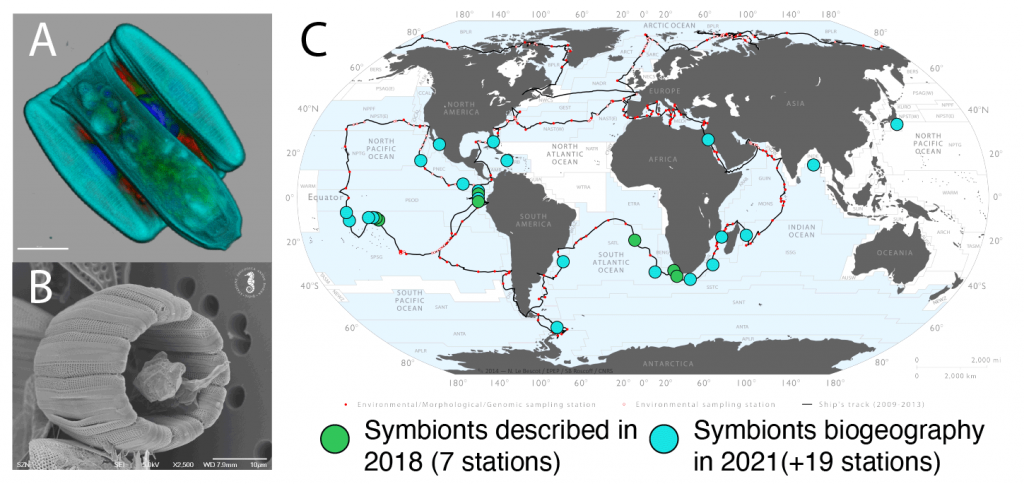
Flora Vincent
Group Leader
ORCID: 0000-0001-6976-3004
EditSymbiosis in marine unicellular eukaryotes

Group Leader
ORCID: 0000-0001-6976-3004
EditSymbiosis – or the state of “living together” – is defined as an intimate interaction between organisms from mutualistic to parasitic relationships. While famous cases such as Wolbachia, lichens or coral reefs demonstrate how symbiosis can modify organisms’ metabolism, morphological development, as well as ecological and evolutionary processes, little is known in remote ecosystems such as the ocean. In particular, unicellular eukaryotes (“protists”) dominate the ocean’s biomass, and fewer than 1500 symbioses have been described despite approximately 130,000 protist species. What is the diversity of microbial symbioses and how do they impact protist development as well as larger ecosystem processes?
To explore these questions, we focus on phytoplankton: prolific unicellular organisms responsible for 50% of photosynthesis on Earth, which form annual blooms covering thousands of square kilometres. By tapping into samples collected during the Tara Ocean’s expedition and combining single cell isolation, genotyping and imaging, we have previously uncovered symbiotic interactions involving diatoms and ciliates suggesting important potential for more discoveries (Video 1) (Vincent et al. 2018). Our more recent work explores the impact of host-pathogen interactions on microbial communities and carbon cycling. By applying quantitative single-cell in situ hybridization (Vincent et al. 2021a, b) and transcriptomics in lab-based and natural samples, our work highlights the power of integrating cell biology approaches with ecosystem sciences, notably through single-cell ecology and large-scale sampling expeditions (Figure 1).

Being part of both the Developmental Biology unit and the Planetary Biology transversal theme, we collaborate with labs across EMBL (e.g., Pepperkork group, van Gestel group) as well as with larger consortiums (e.g. Tara Oceans).
What are the ecological drivers of diatom symbioses?
We estimate that half of the diatom symbioses remain to be discovered. Our aim is to provide an unbiased and comprehensive view of the morpho-genetic diversity and hotspots of diatom symbioses, by developing high-throughput screening methods of natural samples. These approaches can be expanded to discover other ecologically prevalent interactions, thus providing a global-scale understanding of protist symbiosis diversity and ecological drivers. Given the abundance of unicellular microbes in the ocean and evidence for the critical role of symbiosis in maintaining key marine ecosystem processes, a detailed understanding of planktonic symbioses biogeography is a pressing requirement of environmental science.
How does mutualism shape the morphogenetic space of multicellular assembly?
Photosynthetic diatoms establish mutualistic interactions with heterotrophic motile protists, leading to a multicellular assemblage that dramatically departs from the original form and function of individual partners (Figure 2). Despite being observed across a diverse range of species and environments, we still lack a clear understanding of the holobiont’s life cycle. We will combine lab-based and in natura experiments to understand how and why such mutualistic interactions develop in time and space. As all forms of multicellular life, from fungi to humans, originated as single-cell organisms, most likely in the aquatic environment, a deeper understanding of symbiosis in marine unicellular eukaryotes can shed light on fundamental processes predating the development of plant and animal multicellularity.

How does diatom parasitism impact marine ecosystems?
The ocean contains an estimated 662 Pg of carbon in the form of dissolved organic carbon (DOC), which partially originates from diatom cell leakage, exudation, and lysis. Marine bacteria play an important role in the recycling of organic carbon: they break down high molecular weight compounds and use the products for growth to become themselves a food source for higher trophic levels. However, diatom parasites could potentially challenge this foundational concept by competing with bacteria. We will examine the interplay between the diatom/parasite/bacteria partners and carbon recycling using model system species to better understand the impact of eukaryotic and bacterial recyclers on ecosystem functioning.